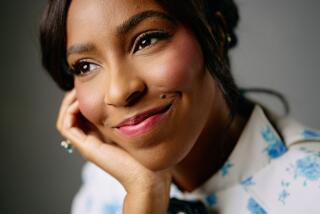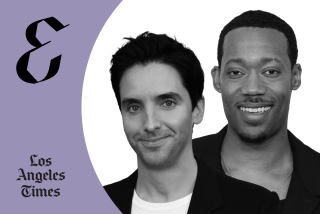Dr. Joyce Brothers dies at 85; popular TV psychologist
Fame was never her intent, Dr. Joyce Brothers often said.
She was not yet 30, new to stay-at-home motherhood and struggling to help her husband stretch his pay as a medical resident when she came up with an ambitious plan: Transform herself into a boxing expert and try out for “The $64,000 Question,” a popular 1950s television quiz show. “Gee, a loser on those shows gets a Cadillac,” she once recalled, “and I could be a loser.”
Instead, she won big and used her instant celebrity to establish a new media specialty — pop psychology.
PHOTOS: Joyce Brothers | 1927-2013
Brothers went on to become a household name, ministering to America’s collective psyche via TV, radio, magazines and newspapers. Part of her popularity stemmed from her engaging on-screen presence and willingness to publicly address what were then borderline taboo subjects, such as sexual fulfillment and infidelity.
It was a jarring and significant achievement in mid-20th century America, when television’s fictional couples were still portrayed as sleeping in separate beds. By showcasing her psychological expertise on NBC as early as 1958, she paved the way for others in her field to carve out careers on television and ultimately helped demystify and popularize psychology.
Brothers, who held a doctorate in psychology from Columbia University, died Monday of respiratory failure after a long illness. She was 85 and lived in Fort Lee, N.J.
“She was the first to open up the public airwaves to private feelings. There was no one like that,” Ron Simon, curator of the Paley Center for Media in New York, said in 2006 in the Bergen County, N.J, Record. “Now, so many programs deal with these intimate matters.”
PHOTOS: Notable deaths of 2013
Before she could jump from the halls of academe to pioneer what became known as “media psychology,” Brothers had to pitch herself to “The $64,000 Question.”
The game show liked to feature contestants who seemed at odds with their area of expertise, so the exceedingly feminine psychologist claimed to be an authority on boxing.
When producers bought it, she spent a few weeks turning herself into an expert, watching the “Greatest Fights of the Century” series and tracking down issues of the boxing magazine the Ring.
“I just read everything,” she later said.
Although she quickly established herself as a formidable contestant in the fall of 1955, show sponsor Charles Revson — head of cosmetics company Revlon — didn’t like what he saw. She wouldn’t wear makeup, and he wanted her off the air.
Producers instructed her to lose at the $16,000 level, but she refused to buckle, she told The Times in 1981.
“They were going to knock me out with impossible questions, but they didn’t,” Brothers later recalled. “I’d memorized everything it is possible to know on the subject.”
For instance, she was asked to give the full name of the Marquess of Queensberry (John Sholto Douglas), known for the rules of boxing; and the length of the 1923 Jack Dempsey-Luis Firpo bout (3 minutes, 57 seconds).
By December, she had won the top prize. Two years later, Brothers returned to win another $70,000 when she took on a group of former prizefighters on “The $64,000 Challenge,” a spinoff of the original show.
Her winnings equaled about $1 million in today’s dollars, “enough to promise myself I’d never do anything I didn’t want to again,” she later said.
When the scandal over quiz-show rigging erupted in 1959, Brothers’ honesty was documented. Summoned to testify, she “survived unscathed,” The Times reported in 1981. They “asked me boxing questions all day long and I got every one right,” Brothers said.
In 1958 “The Dr. Joyce Brothers Show” debuted on NBC’s New York affiliate. The afternoon talk show dispensed advice on child rearing, love, marriage and sex. An instant hit, it was soon airing nationally.
Moving to late-night TV in the early 1960s allowed Brothers to speak more frankly. The program ran for five years, one of a number of her advice shows that aired over the ensuing decades on television and radio.
She also wrote a syndicated column that appeared in about 350 daily newspapers and was a frequent, often cheeky guest on television talk and game shows.
At first, fellow psychologists complained that Brothers’ analysis only skimmed the surface, and many believed that sharing psychological advice outside the office was inappropriate, according to the American Psychology Assn.
But over time psychologists found value in the fact that she had introduced many people to their profession and had connected it to the term “doctor,” former association President Frank Farley said in 2011 in the organization’s Monitor on Psychology magazine.
Brothers was also game to send up her image as the brainy yet frank and chatty psychologist, often making cameo appearances on TV and in such films as “The King of Comedy” (1983) and “Analyze That” (2002).
When asked why the public was hungry for personal advice from a public person, she proposed that an increasingly mobile society had heightened feelings of isolation.
“There is a lot more searching for answers these days,” Brothers told the Washington Post in 1979. “And a lot more answers too. But we’re missing friends and kinship roles. So you rent a friend. Like Dr. Joyce Brothers.”
Joyce Diane Bauer was born Oct. 29, 1927, in New York City to Morris and Estelle Bauer, lawyers who practiced together and raised their two children on Long Island. Her younger sister, Elaine, became a lawyer and judge.
While earning her bachelor’s degree in home economics from Cornell University, Brothers developed an interest in psychology. She graduated at 19 in 1947.
At Columbia, she studied psychology, earning a master’s degree in 1950 and a doctorate three years later. She wrote her dissertation on anxiety avoidance and escape behavior.
While vacationing in the Catskill Mountains, she met Milton Brothers. They married in 1949 and eventually split their time between Fort Lee, N.J., and a farm in New York State. She had stopped teaching to stay home with their young daughter when she decided to try to make extra cash as a game-show contestant.
Her husband became an internist who specialized in treating diabetes but “smoked like a furnace … a continual bone of contention between us,” Brothers later wrote. He died of cancer at 62 in 1989.
Unprepared for the profound grief she experienced, Brothers wrote a 1990 book about it, “Widowhood,” which recounted her journey back to a productive life. It was the most personal, and most popular, of her 10 books, according to the reference “Jewish Women in America.”
Later in life, she often took the family of her only child — Dr. Lisa Brothers Arbisser, an ophthalmologist in Iowa — on “adventures” or indulged in separate trips with each of her four grandchildren. They survive Brothers, as do two great-grandchildren and her sister, Elaine Goldsmith.
One demographic that did not seek her advice was her own family.
“She totally loses her objectivity,” her husband told UPI in 1985. “With her family, she’s abysmal.”
More to Read
Start your day right
Sign up for Essential California for the L.A. Times biggest news, features and recommendations in your inbox six days a week.
You may occasionally receive promotional content from the Los Angeles Times.







